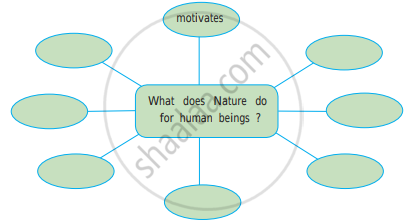Advertisements
Advertisements
प्रश्न
Prepare a Fact file of any of the following plants/trees, using the points given.
[coconut / neem / basil / cactus / apple]
- Name of Plant/Tree _________
- Scientific name ___________
- Region and climate ___________
- Features ___________
- Growth _____________
- Size, shape and colour ____________
- Uses __________
- Any special feature ________
उत्तर
Profile of the Coconut Tree and Fruit
- Names:
English name Coconut;
Sanskrit name - Narikela;
Hindi name - Nariyal. - Scientific name:
cocos nucifera; belongs to the family 'Palmae' or the palm family (also known as Arecaceae). - Region and Climate:
Tropical and sub tropical coastal regions, especially near sea beaches. - Features:
i. Fruit: has a thick fibrous coir over the hard shell: inside the kernel colourless liquid;
ii. leaves: feather-shaped and split into lots of leaflets. - Growth:
Coconut trees can grow from 15 to 30 metres in height in plantations - Size and shape:
Coconut fruits are oval in shape. The trunk of the coconut tree is ringed with scars where old leaves have fallen. The top of the trunk is crowned with a rosette of leaves. The leaves can grow up to 7 feet long and can have 250 leaflets. - Uses:
i. Coir weaving and leaves: matting, thatching and
ii. Hard outer shell: about 10 to 15 inches in length: used to make articles such as spoons, eating utensils, charcoal, etc.
iii. Inside of the shell: lined with a white edible layer called the meat: used for cooking or extraction of oil, making of soaps or cosmetics: also to make chemical Industrial and medicinal products: contains coconut water which is very nutritious.
iv. Husk and leaves: used as material to make a variety of products for furnishing and decorating - Any special feature:
Known in India as kalpavriksha' or the tree of heaven' because of its many uses: the term coconut is derived from the 16th century Portuguese and Spanish. meaning grinning face from the three small holes on the coconut shell that resemble human facial features.
APPEARS IN
संबंधित प्रश्न
What things in nature teach us the following:
Delicate structures are not a sign of weakness ______.
Read the question from the lesson. What do they imply?
What if we too had lived our lives, however short, to the fullest?
Fill the web

Think and answer in your own words.
How does nature succeed in its ‘Alchemy’? What can it turn a small person into?
Look at the following thing. Discuss with your friend, what you learn from them.
An eagle
Look at the following things. Discuss with your friend, what you learn from them.
The river
Look at the following things. Discuss with your friend, what you learn from them.
Rainfall
Look at the following things. Discuss with your friend, what you learn from them.
Sun
Go through the text again and complete the web that highlights the various features of flower of the ‘hibiscus’ plant. One is done for you.

The author has very positively described the different things in nature. Discuss with your partner the special features of each one of them. Add on the list.
| Part of Nature | Special Feature | Value Learnt |
| 1. Water | ||
| 2. Rainbow | ||
| 3. Caterpillar | ||
| 4. | ||
| 5. | ||
| 6. | ||
| 7. | ||
| 8. | ||
| 9. | ||
| 10. |
